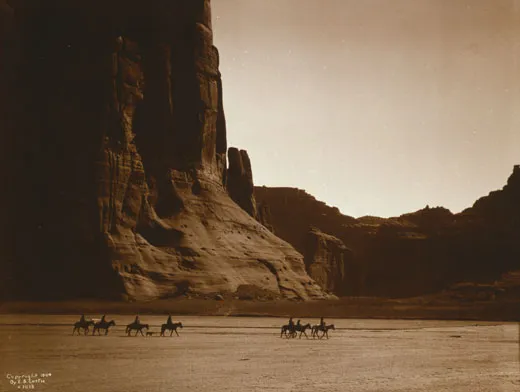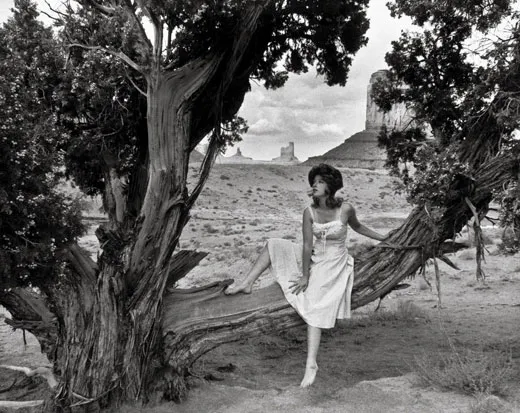Cindy Sherman: Monument Valley Girl
The artist’s self portrait plays with our notions of an archetypal West
/https://tf-cmsv2-smithsonianmag-media.s3.amazonaws.com/filer/Cindy-Sherman-self-portrait-631.jpg)
The enduring image of the American West is one of endless plains and unpopulated vistas. In a 1904 photograph by Edward Curtis, the monumental cliffs of Canyon de Chelly in northern Arizona dwarf the Navajo horsemen riding by.
Then there's the photograph on this page, made in 1979: a lone woman sits on a tree branch in a desolate precinct of Monument Valley, near the border of Arizona and Utah. She—not the landscape—is the subject. Who is she? Why does she look as fresh as a cactus flower? And what is this photograph doing in the same exhibition as the Curtis picture from 1904?
The exhibition, "Into the Sunset: Photography's Image of the American West," goes on display March 29 at the Museum of Modern Art in New York City (through June 8). Almost any survey of photography and the American West would include work from the expeditions Curtis made between 1900 and 1930 to document the lives of Native Americans. This picture, by Cindy Sherman, is a bit of a surprise. Sherman, born in 1954, is best known for dressing up in character and photographing herself. (That is her posing as what she calls a "Monument Valley girl.") What do Sherman's self-portraits have to do with the mythologies of the West?
This image is one of a series of what she calls "film stills," made between 1977 and 1980. In each she photographed herself in black and white dressed as a generic character inspired by movies of the 1940s, '50s and '60s. The scenes were narratives "without involving other people, just suggesting them outside the frame," she wrote in the preface to her book The Complete Untitled Film Stills. She avoided putting titles on the images to preserve their ambiguity. (This one is Untitled Film Still #43.) She wanted viewers to be able to invent their own stories to suit the scene, perhaps even insert themselves in it. The women in these photographs, she wrote, "are on their way to wherever the action is (or to their doom)...or have just come from a confrontation (or a tryst)."
Sherman made this photograph while on a vacation with her parents. She loaded a camera, a tripod and a suitcase full of wigs, makeup and costumes into a station wagon, and whenever she saw an interesting location she asked her parents to stop while she set up a scene to shoot. She says she was interested in playing with stereotypes and visual clichés.
Sherman has said she "didn't want to compete with the landscape" in the pictures she made in Arizona, but this one shows her ability to do so. Her centrality in the foreground helps, but so does her pose, with a bare leg on the tree limb echoing the shape of the cliff behind her. The picture subtly suggests a relationship between women and nature that is missing from the generic Western landscape.
Although director John Ford's most famous westerns, including Stagecoach and The Searchers, were filmed in Monument Valley, Sherman's photograph resists any reference to cowboys or Indians. Instead, it offers an alternative mythology, with a woman displacing Curtis' horsemen or Clint Eastwood's "man with no name." (Her other Arizona film stills feature other kinds of women, as if to suggest that the possibilities of the frontier include self-invention.)
"Our image of the West was always constructed," says Eva Respini, assistant curator of photography at MoMA, who organized "Into the Sunset." "Curtis' Canyon de Chelly is a fabrication, just like Sherman's." And just as Sherman uses costume to transform herself, Curtis sometimes had his Native American subjects change into traditional dress. "She may look here like a wistful, lonesome country girl," says Respini of Sherman, "but she's really playing a Western type."
Sherman stopped taking her film stills photographs around 1980. "I knew it was over when I started repeating myself," she wrote. She has spent the decades since exploring role-playing through color self-portraits.
Americans may have run out of frontier, but we haven't given up our preoccupation with it. Joan Didion wrote in Where I Was From that California, where her family lived for generations, remains a "wearying enigma...we worry it, correct and revise it, try and fail to define our relationship to it and its relationship to the rest of the country." The same holds true for the wider West. But each revision has the potential to show us something new. Cindy Sherman redefined the valley, and the girl.
Victoria Olsen is the author of From Life: Julia Margaret Cameron and Victorian Photography.
Planning Your Next Trip?
Explore great travel deals
Smithsonian magazine participates in affiliate link advertising programs. If you purchase an item through these links, we receive a commission.

